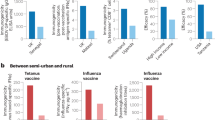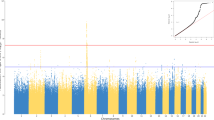Abstract
Infant immunization is the most cost-effective strategy to prevent infectious diseases in childhood, but is limited by immaturity of the immune system. To define strategies to improve vaccine immunogenicity in early life, the role of genetic and environmental factors in the control of vaccine responses in infant twins was studied. Immune responses to BCG, polio, hepatitis B, diphtheria, pertussis and tetanus vaccines were measured at 5 months of age in 207 Gambian twin pairs recruited at birth. Intrapair correlations for monozygous and dizygous pairs were compared to estimate the environmental and genetic components of variation in responses. High heritability was observed for antibody (Ab) responses to hepatitis B (77%), oral polio (60%), tetanus (44%) and diphtheria (49%) vaccines. Significant heritability was also observed for interferon-γ and interleukin-13 responses to tetanus, pertussis and some BCG vaccine antigens (39–65%). Non-HLA genes played a dominant role in responses to Ab-inducing vaccines, whereas responses to BCG were predominantly controlled by genes within the HLA class II locus. Genetic factors, particularly non-HLA genes, significantly modulate immune responses to infant vaccination. The identification of the specific genes involved will provide new targets for the development of vaccines and adjuvants for young infants that work independently of HLA.
This is a preview of subscription content, access via your institution
Access options
Subscribe to this journal
Receive 6 digital issues and online access to articles
$119.00 per year
only $19.83 per issue
Buy this article
- Purchase on Springer Link
- Instant access to full article PDF
Prices may be subject to local taxes which are calculated during checkout
Similar content being viewed by others
References
Marchant A, Newport MJ . Prevention of infectious diseases by neonatal and early infantile immunisation: prospects for the new millennium. Curr Opin Infect Dis 2000; 13: 241–246.
Siegrist CA . Neonatal and early life vaccinology. Vaccine 2001; 19: 3331–3346.
Lewis DB, Wilson CB . Developmental immunology and role of host defenses in fetal and neonatal susceptibility to infection. In: Remington JS, Klein JO (eds). Infectious Diseases of The Fetus and Newborn. WB Saunders: Philidelphia, 2001: 25–138.
Barrios C, Brawand P, Berney M, Brandt C, Lambert PH, Siegrist CA . Neonatal and early life immune responses to various forms of vaccine antigens qualitatively differ from adult responses: predominance of a Th2-biased pattern which persists after adult boosting. Eur J Imunol 1996; 26: 1489–1496.
Goriely S, Vincart B, Stordeur P et al. Deficient IL-12 (p35) gene expression by dendritic cells derived from neonatal monocytes. J Immunol 2001; 166: 2141–2146.
Fink C, Miller WE, Dorward B . The formation of macroglobulin antibodies. II. Studies on neonatal infants and older children. J Clin Invest 1962; 41: 163–183.
Smith DH, OPeter G, Ingram DL, Harding AL, Anderson P . Responses of children immunized with the capsular polysaccharide of Hemophilus influenzae, type b. Pediatrics 1973; 52: 637–644.
Lieberman JM, Greenberg DP, Wong VK et al. Effect of neonatal immunization with diphtheria and tetanus toxoids on antibody responses to Haemophilus influenzae type b conjugate vaccines. J Pediatr 1995; 126: 198–205.
Gans HA, Arvin AM, Galinus J, Logan L, DeHovitz R, Maldonado Y . Deficiency of the humoral response to measles vaccine in infants immunized at 6 months of age. JAMA 1998; 280: 527–532.
Gans H, Yasukawa L, Rinki M et al. Immune responses to measles and mumps vaccination of infants at 6, 9, and 12 months. J Infect Dis 2001; 184: 817–826.
Shiokawa S, Mortari F, Lima JO et al. IgM heavy chain complementary-determining region 3 diversity is constrained by genetic and somatic mechanisms until two months after birth. J Immunol 1999; 162: 6060–6070.
Pollard AJ, Levin M . Production of low-avidity antibody by infants after infection with serogroup B meningococci. Lancet 2000; 356: 2065–2066.
Goldblatt D, Vaz AR, Miller E . Antibody avidity as a surrogate marker of successful priming by Haemophilus influenzae type b conjugate vaccines following infant immunization. J Infect Dis 1998; 177: 1112–1115.
Plebani A, Ugazio AG, Avanzini MA et al. Serum IgG subclass concentrations in healthy subjects at different age: age normal percentile charts. Eur J Pediatr 1989; 149: 164–167.
Vekemans J, Ota MO, Wang EC et al. T cell responses to vaccines in infants: defective IFNgamma production after oral polio vaccination. Clin Exp Immunol 2002; 127: 495–498.
Rowe J, Macaubas C, Monger T et al. Heterogeneity in diphtheria–tetanus–cellular pertussis vaccine specific cellular immunity during infancy: relationship to variations in the kinetics of postnatal maturation of systemic Th1 function. J Infect Dis 2001; 184: 80–88.
Cutts F, Olive J-M . Vaccination programmes in developing countries. In: Plokin SA, Orenstein WA (ed). Vaccines 3rd edn. WB Saunders: Philadelphia, 1999: 1047–1073.
Siegrist CA, Lambert PH . Maternal immunity and infant responses to immunization: factors influencing infant responses. Dev Biol Stand 1998; 95: 133–139.
Rosen FS . Genetic deficiencies in specific immune responses. Semin Hematol 1990; 27: 333–341.
Reith W, Mach B . The bare lymphocyte syndrome and the regulation of MHC expression. Annu Rev Immunol 2001; 19: 331–373.
Singh N, Agrawal S, Rastogi AK . Infectious diseases and immunity: special reference to major histocompatibility complex. Emerg Infect Dis 1997; 3: 41–49.
Stein CM, Guwatudde D, Nakakeeto M et al. Heritability analysis of cytokines as intermediate phenotypes of tuberculosis. J Infect Dis 2003; 187: 1679–1685.
Stephensen CB . Vitamin A, infection and immune function. Annu Rev Nutr 2001; 21: 167–192.
Sjoberg K, Lepers JP, Raharimalala L et al. Genetic regulation of human anti-malarial antibodies in twins. Proc Natl Acad Sci USA 1992; 89: 2101–2104.
Cooke GS, Hill AVS . Genetics of susceptibility to human infectious disease. Nat Rev Genet 2001; 2: 967–977.
Dubowitz LMS, Dubowitz V, Goldberg C . Clinical assessment of gestational age in the newborn infant. J Pediatr 1970; 77: 1–10.
Becker A, Busjahn A, Faulhaber H, Bahring S, Robertson J, Luft F . Twin zygosity. Automated determination with microsatellites. J Reprod Med 1997; 42: 260–266.
Ota M, Vekemans J, Schlegel S et al. Influence of Mycobacterium bovis bacillus Calmette–Guerin on antibody and cytokine responses to human neonatal vaccination. J Immunol 2002; 168: 919–925.
Neale MC, Miller MB . The use of likelihood-based confidence intervals in genetic models. Behav Genet 1997; 27: 113–120.
Jepson AP, Banya WAS, Sisay-Joof F et al. Quantification of the relative contribution of major histocompatibility complex (MHC) and non-MHC genes to human immune responses to foreign antigens. Infect Immun 1997; 65: 872–876.
Konradsen H, Henrichsen J, Wachmann H, Holm N . The influence on genetic factors on the immune response as judged by pneumococcal vaccination of mono and dizygotic Caucasian twins. Clin Exp Immunol 1993; 92: 532–536.
Hohler T, Reuss E, Evers N et al. Differential genetic determination of immune responsiveness to hepatitis B surface antigen and to hepatitis A virus: a vaccination study in twins. Lancet 2002; 360: 991–995.
Bishop GA, Hostager BS . B lymphocyte activation by contact-mediated interactions with T lymphocytes. Curr Opin Immunol 2001; 13: 278–285.
Walker BD, Korber BT . Immune control of HIV: the obstacles of HLA and viral diversity. Nat Immunol 2001; 2: 473–475.
Poland GA . Variability in immune response to pathogens: using measles vaccine to probe immunogenetic determinants of response. Am J Hum Genet 1998; 62: 215–220.
Egea E, Iglesias A, Salazar M et al. The cellular basis for lack of antibody response to hepatitis B vaccine in humans. J Exp Med 1991; 173: 531–538.
Poland GA, Ovsyannikova IG, Jacobson RM et al. Identification of an association between HLA class II alleles and low antibody levels after measles immunization. Vaccine 2001; 20: 430–438.
Gelder CM, Lambkin R, Hart KW et al. Associations between human leukocyte antigens and nonresponsiveness to influenza vaccine. J Infect Dis 2002; 185: 114–117.
Newport MJ, Holland SM, Levin M, Casanova J-L . Inherited disorders of the interleukin-12-interferon gamma axis. In: Ochs HD, Smith E, Puck JM (eds). Primary Immunodeficiency Diseases. A Molecular and Genetic Approach. Oxford University Press: Oxford, 2003, (in press).
van Eden W, de Vries RR, Stanford JL, Rook GA . HLA-DR3 associated genetic control of response to multiple skin tests with new tuberculins. Clin Exp Immunol 1983; 52: 287–292.
Mustafa AS, Shaban FA, Abal AT et al. Identification and HLA restriction of naturally derived Th1-cell epitopes from the secreted Mycobacterium tuberculosis antigen 85B recognized by antigen-specific human CD4(+) T-cell lines. Infect Immun 2000; 68: 3933–3940.
Kaufmann SH . How can immunology contribute to the control of tuberculosis? Nat Rev Immunol 2001; 1: 20–30.
Acknowledgements
We thank the staff of the three enrolment centres and all the twin families for their participation: to Omar Badjie, Dawda Baldeh, Isatou Drammeh, Malick John, Bunja Kebbeh, Suleyman Manjang, Mamadi Sidibeh and Samba Sowe for expert assistance with field work; to Dr Tumani Corrah for help with clinical care of infants; to Dr Mariama Jallow (RVH, Banjul) and Mr JS Saidykhan (Divisional Health Team, Western Kanifing, The Gambia) for guidance during the planning of this project; to Momodou Jobe and Momodou Cham for sample processing, Albert Magnusen, Mariamma Sanneh and Dr Michael Kidd for assistance with antibody assays; to Helen Rance and Sarah Nutland for assistance with HLA typing; to Drs Kris Huygen and Peter Andersen, and to Glaxo SmithKline Biologicals for generously providing antigens; and to Drs Karen Butterworth and Giorgio Sirugo for their contribution to this and ongoing studies in this cohort.
Author information
Authors and Affiliations
Consortia
Corresponding author
Additional information
This study was supported by the Medical Research Council (UK), the WHO Global Program for Vaccines and Immunization, the Wellcome Trust and the Royal Society.
The MRC Twin Study Group
A Allen, W Banya, D Jackson Sillah, KPWJ McAdam, M Mendy, M Ota, J Vekemans (The Medical Research Council Laboratories, The Gambia); K Jobe (The Gambian Expanded Programme on Immunisation, Department of State for Health, Banjul, The Gambia); S Bennett (the MRC Tropical Epidemiology Unit, London School of Hygiene and Tropical Medicine, UK); P Aaby (the Danish Epidemiology Science Centre, Statens Serum Institut, Copenhagen, Denmark); JC Stockton (Department of Medicine, University of Cambridge, UK); G Cadau, P-H Lambert, S Schlegel-Hauter, P Valenti (the WHO Collaborative Centre for Neonatal Vaccinology, University of Geneva, Switzerland).
Rights and permissions
About this article
Cite this article
Newport, M., Goetghebuer, T., Weiss, H. et al. Genetic regulation of immune responses to vaccines in early life. Genes Immun 5, 122–129 (2004). https://doi.org/10.1038/sj.gene.6364051
Received:
Revised:
Accepted:
Published:
Issue Date:
DOI: https://doi.org/10.1038/sj.gene.6364051
Keywords
This article is cited by
-
Polymorphisms within DIO2 and GADD45A genes increase the risk of liver disease progression in chronic hepatitis b carriers
Scientific Reports (2023)
-
Influence of genetics and the pre-vaccination blood transcriptome on the variability of antibody levels after vaccination against Mycoplasma hyopneumoniae in pigs
Genetics Selection Evolution (2021)
-
CRISPR-based strategies in infectious disease diagnosis and therapy
Infection (2021)
-
Impacts of Ecology, Parasite Antigenic Variation, and Human Genetics on RTS,S/AS01e Malaria Vaccine Efficacy
Current Epidemiology Reports (2021)
-
Kinome profiling of peripheral blood mononuclear cells collected prior to vaccination reveals biomarkers and potential mechanisms of vaccine unresponsiveness in pigs
Scientific Reports (2020)



